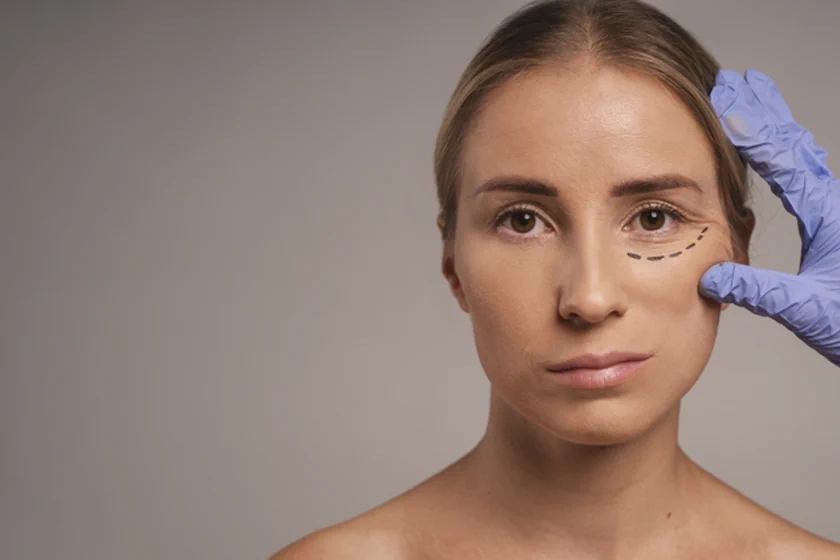|
Getting your Trinity Audio player ready...
|
Dacryocystitis, a condition that results from blocked tear ducts, is not just a mere inconvenience, it’s a health issue that can significantly impact your daily life and overall eye health. Dr. Surbhi Kapadia, a preeminent ophthalmologist in Vadodara, India, delves deep into the causes, symptoms, and treatments of this condition, providing valuable insights for those affected.
What is Dacryocystitis?
Dacryocystitis is an inflammation or infection of the lacrimal sac, an integral part of the tear drainage system located near the inner corner of the eye. This condition can lead to a painful and bothersome blockage of the tear ducts, affecting the drainage of tears and overall eye health.
Acute vs. Chronic Dacryocystitis
Dacryocystitis can present in two forms: acute or chronic. Acute dacryocystitis is marked by sudden onset of very painful, red, and swollen areas around the lacrimal sac. It may be accompanied by fever and a general feeling of malaise. Chronic dacryocystitis, however, develops more slowly and is characterized by persistent tearing, discharge, and mild discomfort, often without significant pain or systemic symptoms.
Prevalence of Dacryocystitis
Dacryocystitis can affect individuals of any age group but is more commonly seen in certain populations due to anatomical variations, environmental factors, or other underlying health issues. It’s a condition that warrants attention due to its potential impact on eye health.
Symptoms and Causes of Dacryocystitis
Dacryocystitis, a condition concerning the tear ducts, can manifest through various symptoms and is caused by several factors. Understanding these symptoms and causes is crucial for early recognition and effective treatment.
Symptoms of Dacryocystitis
The symptoms of dacryocystitis can range from mild discomfort to severe pain and can affect daily activities. Common signs include:
Redness and Swelling: One of the most noticeable signs is redness and swelling near the inner corner of the eye, closer to the nose. This area might feel warm and tender to touch.
Pain: The affected area can be painful, especially in cases of acute dacryocystitis. The pain might intensify when pressing on the side of the nose or the inner corner of the eye.
Tearing: Excessive tearing or watery eyes are common as the inflammation hinders the normal drainage of tears.
Discharge: There may be a sticky or pus-like discharge from the inner corner of the eye. In some cases, pressing on the swollen area can cause this discharge to increase.
Blurry Vision: In some instances, the inflammation can lead to blurry vision if the discharge or tears accumulate in the eye.
Causes of Dacryocystitis
Dacryocystitis occurs when the nasolacrimal duct, responsible for draining tears from the eye to the nose, becomes blocked or infected. Several factors can contribute to this condition:
Infection: The blockage can lead to the accumulation of tears in the lacrimal sac, creating a breeding ground for bacteria and leading to infection.
Congenital Blockage: In newborns, dacryocystitis often occurs due to congenital blockages in the tear duct system. This type of blockage might clear up as the child grows provided certain maneuvers are practiced during younger months of their lives.
Injury or Trauma: Injury to the nose or face can damage the tear ducts, leading to blockages and inflammation.
Previous Eye or nose Surgery: Certain eye surgeries can inadvertently affect the tear ducts, causing dacryocystitis.
Nasal Issues: Conditions like chronic sinusitis or nasal polyps can obstruct the tear ducts, leading to dacryocystitis.
Age-Related Changes: In older adults, changes in the tear ducts’ anatomy can lead to narrowing and blockage, increasing the risk of dacryocystitis.
Understanding the symptoms and causes of dacryocystitis is the first step in seeking appropriate care. If you experience any of these symptoms, especially persistent eye redness, swelling, or discharge, it is advisable to consult the best eye specialist in Vadodara like Dr. Surbhi Kapadia for a thorough evaluation and treatment.
Diagnosis and Tests for Dacryocystitis
Diagnosing dacryocystitis accurately is crucial for effective treatment. Dr. Surbhi Kapadia a leading eye specialist in Vadodara, with her expertise in eye care, utilizes a range of diagnostic methods to confirm dacryocystitis and determine its severity.
Initial Examination
The diagnosis typically begins with a thorough examination of the affected eye. Dr. Kapadia will carefully inspect the eye for signs of redness, swelling, and discharge. She will also assess any tenderness in the area around the tear duct to understand the extent of the inflammation or infection.
Medical History
A detailed medical history helps in understanding the potential causes. This includes asking about any previous eye or nasal conditions, injuries, surgeries, or recurrent symptoms that might have led to the development of dacryocystitis.
Specific Tests for Dacryocystitis
Several tests may be employed to diagnose dacryocystitis:
Tear Duct Probing: A small probe is gently inserted into the tear duct to check for blockages. This simple procedure can often be done in the office.
Dye Disappearance Test: A special dye is placed in the eye, and its rate of disappearance is observed. Slower disappearance can indicate a blockage in the tear drainage system.
Imaging Tests: In some cases, imaging studies such as a dacryocystogram or a CT scan might be recommended. These tests help visualize the tear duct system, revealing blockages or structural abnormalities.
Culture Tests: If an infection is suspected, a culture test of the discharge may be conducted to identify the causative bacteria. This aids in selecting the most effective antibiotics for treatment.
Importance of Accurate Diagnosis
An accurate diagnosis is critical in determining the best course of treatment for dacryocystitis. Depending on whether the condition is acute or chronic, and the underlying cause of the blockage or infection, the treatment plan can vary significantly.
Role of the Eye Specialist
Consulting an eye specialist like Dr. Surbhi Kapadia for symptoms of tear duct infection or inflammation is vital. Her expertise in diagnosing and treating eye conditions ensures that patients receive the most appropriate and effective care for their specific situation.
Management and Treatment of Dacryocystitis
Dealing with dacryocystitis effectively requires a tailored approach, depending on whether the condition is acute or chronic. Dr. Surbhi Kapadia, with her extensive experience in eye care, provides comprehensive treatment options to manage and resolve this condition.
Treatment for Acute Dacryocystitis
In cases of acute dacryocystitis, which is often caused by a bacterial infection, the primary treatment includes:
Antibiotics:Oral or intravenous antibiotics are commonly prescribed to combat the infection. The choice of antibiotic, such as Amoxicillin-clavulanate, Cephalexin, Ciprofloxacin, Clindamycin, or Trimethoprim-Sulfamethoxazole, depends on the specific bacterial infection.
Antibiotic Ointments or Drops: These are used to directly treat the infection in the affected area.
Warm Compresses: Applying warm compresses to the inflamed area can help alleviate discomfort and reduce swelling.
Gentle Massage: Massaging the area around the blocked tear duct can sometimes help to open the blockage and improve drainage.
Patients typically start to feel better a few days after beginning antibiotic treatment. It’s crucial to complete the entire course of antibiotics even if symptoms improve to ensure the infection is fully resolved.
Treatment for Chronic Dacryocystitis
Chronic dacryocystitis often requires a more interventionist approach:
Dacryocystorhinostomy (DCR): DCR surgery is a common and effective treatment for chronic dacryocystitis. This procedure involves creating a new pathway for tears to bypass the blocked duct. Dr. Kapadia’s expertise in this surgical procedure ensures that patients receive the best possible outcomes with minimal complications.
Ongoing Monitoring: Chronic conditions may require regular follow-up visits to monitor the situation and prevent recurrence.
Management in Infants
Babies with neonatal dacryocystitis often outgrow the condition within a year. In the meantime, conservative treatments like gentle massage and cleaning of the eye area are usually recommended. If recurrent episodes occur, further evaluation and treatment may be necessary.
Complications and Risks
While treatments like DCR are generally safe and effective, as with any surgical procedure, there are potential risks and complications, such as:
Excessive Bleeding: Though rare, surgery can sometimes lead to bleeding.
Infection: There’s a small risk of infection post-surgery, which is usually manageable with antibiotics.
Sinusitis: Since DCR involves creating a new tear pathway near the sinus, there’s a slight risk of developing sinusitis.
Injuries to Eye or Nose Structures: Skilled surgeons like Dr. Kapadia minimize this risk through precise surgical techniques.
Effective management of dacryocystitis requires a thorough understanding of the condition and a personalized approach to treatment. Dr. Surbhi Kapadia’s comprehensive care ensures that patients in Vadodara receive the best treatment, tailored to their specific needs, whether it’s through medication or surgical intervention.
Prevention
Preventive strategies for dacryocystitis include maintaining good eye hygiene, protecting the eyes from injuries, and being alert to early signs of tear duct issues. Regular eye check-ups can also help in early detection and prevention of complications.
Outlook / Prognosis
With appropriate and timely treatment, the prognosis for individuals with dacryocystitis is generally favourable. Early medical or surgical intervention can prevent long-term complications, ensuring a swift recovery and maintaining eye health.
Living With Dacryocystitis
Living with dacryocystitis involves adhering to the treatment regimen prescribed by your eye specialist, which may include antibiotic therapy, regular cleansing of the eye, and in some cases, surgical interventions. Following these guidelines is crucial for effective management and recovery.
Common Questions Answered
When should I see a doctor for dacryocystitis?
If you experience symptoms such as persistent eye discharge, pain, redness, or swelling near the tear duct, it’s advisable to consult an eye specialist.
Can dacryocystitis lead to serious complications?
If left untreated, dacryocystitis can lead to complications like infection spreading to surrounding tissues. Early treatment is key to preventing such issues.
What are the latest treatment options for dacryocystitis?
Advances in medical and surgical treatments, including minimally invasive surgical techniques, offer effective solutions for managing dacryocystitis.
What is the Treatment Cost of Dacryocystitis in India?
Understanding the financial aspect of dacryocystitis treatment is crucial for patients planning their care. In India, the cost of treating dacryocystitis can vary significantly based on various factors.
Factors Influencing Treatment Cost
Type of Treatment: The cost largely depends on whether the treatment is medical or surgical. Antibiotic treatments are generally more affordable than surgical interventions like Dacryocystorhinostomy (DCR).
Location of the Clinic or Hospital: The geographical location of the healthcare facility can impact the cost. Metropolitan cities might have higher treatment costs compared to smaller towns.
Healthcare Facility’s Standard: The cost can also vary depending on whether the treatment is at a private clinic, a government hospital, or a specialty eye hospital.
Eye Surgeon’s Expertise: The experience and reputation of the ophthalmologist can influence the cost, especially for surgical procedures.
Additional Tests and Procedures: Sometimes, additional diagnostic tests or follow-up procedures are required, which can add to the overall cost.
Post-Treatment Care: The expenses for any medications, post-operative care, or follow-up visits also need to be considered.
Estimated Cost Range
Medical Treatment: The cost for antibiotic therapy and other non-surgical treatments might range from a few hundred to a few thousand Indian Rupees, depending on the medication prescribed.
Surgical Treatment: DCR and other surgical procedures can be more costly. The price range for these surgeries in India can vary widely, from tens of thousands to over a lakh of Rupees, based on the factors mentioned above.
Insurance and Financial Assistance for Dacryocystitis Treatment
Many health insurance policies cover eye treatments, including surgeries like DCR. Patients should check with their insurance providers for the specifics of their coverage. Dr. Surbhi Kapadia’s practice at Aadicura Superspeciality Hospital, Vadodara, acknowledges the financial aspects of healthcare and strives to make treatments more accessible and affordable for patients. To this end, the hospital has empanelment with a range of insurance companies and corporate entities.
Corporate Tie-Ups
Understanding that healthcare benefits are a vital part of employee welfare, Aadicura Superspeciality Hospital has established corporate tie-ups with several renowned companies. These partnerships facilitate eye care treatments for employees and their families under corporate health schemes. The list of corporate tie-ups includes:
- Linde Engineering India Pvt. Ltd.
- MG Motor India Pvt. Ltd.
- Oil and Natural Gas Corporation (ONGC)
- OPI Industries Pvt. Ltd.
- POLY CAB
- Prajapita Brahmakumari Ishwariya Vishwavidyalaya.
- Schott Glass India Pvt. Ltd.
- Silox India Private Limited.
- Kotak Mahindra General Insurance Co. Ltd. Taj Vivanta.
- L&T (Larsen & Toubro)
Mediclaim Cashless Empanelment
To further ease the financial burden on patients, Aadicura Superspeciality Hospital is empanelled with several health insurance providers & TPAs for cashless mediclaim services. This arrangement ensures that patients can avail themselves of necessary treatments without worrying about immediate out-of-pocket expenses. The hospital is empanelled with the following insurance & TPA companies:
- Aditya Birla Health Insurance Co. Ltd.
- Bajaj Allianz General Insurance Co. Ltd.
- Chola MS Health Insurance Co. Ltd.
- HDFC Ergo General Insurance Co. Ltd.
- SBI General Insurance Co. Ltd.
- FHPL Network
- Paramount Health Services & Insurance TPA
- TATA AIG
Patients with health insurance policies from these providers can seek consultations and treatments, including those for dacryocystitis, under the cashless facility. The hospital’s administrative / TPA staff assists patients in navigating their insurance policies and claim processes, ensuring a smooth and hassle-free experience.
Conclusion
Dacryocystitis, while a common eye condition, requires careful attention and expert care. With Dr. Surbhi Kapadia’s expertise in ophthalmology, patients in Vadodara have access to state-of-the-art care for dacryocystitis and other eye conditions. If you’re experiencing symptoms suggestive of dacryocystitis, timely consultation with the best eye specialist in Vadodara like Dr. Kapadia can be crucial for your eye health.
![]()







